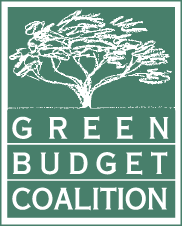Canada needs a whole-of-government approach to ensure major government regulation, policy, and spending align with its targets for emissions reductions and halting and reversing biodiversity loss, as well as the National Adaptation Strategy. It is critical to ensure that major federal budget allocations are leveraged as effectively as possible, and that funding recipients advance Canada’s climate change mitigation, nature and adaptation objectives.
Application of ambitious climate and biodiversity conditions to funds would strengthen the country’s net-zero, adaptation and nature-positive governance by helping mainstream priorities across programs and departments, including large federal mechanisms like the Canada Infrastructure Bank and the Canada Growth Fund. Failure to apply conditions could result in inefficient or risky spending (e.g., on unproven or costly solutions), creating opportunity costs for climate spending.
All departments have important roles in implementing these conditions. In our view, these conditions are of particular importance for PCO, PMO, ISED, NRCan, FIN, TC, DFO, and CIB, given these actors’ roles in moving Canada’s public and private sectors towards net-zero and nature-positive outcomes, and improving resilience.
Recommendations:
- Implement an Integrated Climate and Biodiversity Lens to evaluate Budget 2024 proposals. Budget 2024 should publish a summary of the Budget’s overall climate and biodiversity impact, using transparent methodologies and measurable indicators, including assessment against 1.5-degree scenarios. Further, this Integrated Climate and Nature Lens should be part of the Impacts Reports included in federal budgets. [PCO, FIN, ECCC]
- Align spending by large mechanisms, programs, and budgets41 with 1.5-degree and nature-positive scenarios through robust criteria and conditions. [All departments]
- Make access to major funding, across all streams and programs, conditional on commitments by private and public recipients to achieve Canada’s climate and nature goals.
- For climate-related funding, recipients must have: (1) 2030 and 2050 emissions- reduction targets consistent with or exceeding Canada’s goals; (2) plans to meet these targets informed by the High- Level Expert Group on the Net-Zero Emissions Commitments of Non-State Entities recommendation that net-zero commitments align with 1.5°C pathways with no or limited overshoot; and (3) robust climate and nature-related risk disclosure.
- For electricity, require provinces to commit to systematic improvements to their electricity systems, including mandating public electricity utilities to have net-zero plans (see Advancing a zero-emissions electricity grid based on renewables, earlier in this document).
- For adaptation funding granted to municipalities, provinces and territories that have an adaptation plan or that wish to develop one, plans must be aligned with 1.5-degree scenarios (see Ramping up core adaptation investments to increase resiliency in the face of climate change, later in this document).
- For nature-related funding, recipients must have goals and plans aligned with Canada’s goal of halting and reversing biodiversity loss by 2030, including by protecting at least 30% of land and ocean by 2030, and supporting Indigenous-led conservation;
- Funding should come with penalties and corrective actions if conditions are not met (e.g., grants are converted into loans if the commitment to net-zero has not been developed within a reasonable time period).
- Ensure selection criteria maximize climate- and nature-positive outcomes and are based on:
- The largest net GHG reduction per dollar invested;
- Focus on proven solutions to achieve near-term reductions to reach Canada’s 2030 target versus longer-term emerging technologies;
- Use of best-in-class technology for industrial emissions reduction projects;
- Projects that support long-term and net-zero-consistent job creation and fully integrate sustainable transition elements (i.e., retraining, skill development, community-benefits agreements), with a focus on equity-deserving communities;
- For infrastructure funding, for example, funding for linear infrastructure (e.g., highways and railways) should require the incorporation of wildlife mitigation considerations and measures (e.g., underpasses, overpasses, fencing);
- Bilateral Nature Agreements providing federal nature funding to provinces and territories should require commitment to measurable and specific additional conservation outcomes that meet agreed- to standards and make a significant contribution to the 30% land protection targets, including Indigenous-led conservation initiatives.
- Support transparency and accountability for climate and nature outcomes with robust reporting requirements for programs and participants.
- Details of funding agreements should be made public, and recipients should have an obligation to disclose information on actual investments made and measurable outcomes achieved, especially in terms of GHG reductions, protection and/or restoration of nature, and job creation/retention;
- The government should provide timely, public, monitoring and evaluation reports that assess whether funds are contributing to net-zero and nature-related goals, and reaching the right types of applicants and projects.
- Ensure that Indigenous authority is upheld, including through the integration of free, prior and informed consent and adherence to the United Nations Declaration on the Rights of Indigenous Peoples (UNDRIP) in project- information disclosure and Nation-to-Nation funding arrangements (e.g., through direct transfers to Indigenous recipients).
